29 JAN 1768 AUTOMOBILES INVENTION
History of the automobile
From Wikipedia, the free encyclopedia
The early history of the automobile can be divided into a number of eras, based on the prevalent means of propulsion. Later periods were defined by trends in exterior styling, size, and utility preferences.
In 1768, the first steam powered automobile capable of human transportation was built by Nicolas-Joseph Cugnot.[1]:14
In 1807, François Isaac de Rivaz designed the first car powered by an internal combustion engine fueled by hydrogen.
In 1886 the first petrol or gasoline powered automobile the Benz Patent-Motorwagen was invented by Karl Benz.[2] This is also considered to be the first "production" vehicle as Benz made several identical copies.
At the turn of the 20th century electrically powered automobiles appeared but only occupied a niche market until the turn of the 21st century.
Eras of invention[edit]
Early automobiles[edit]
Steam-powered wheeled vehicles[edit]
Main article: History of steam road vehicles
17th and 18th centuries[edit]
Ferdinand Verbiest, a member of a Jesuit mission in China, built the first steam-powered vehicle around 1672 as a toy for the Chinese Emperor. It was of small enough scale that it could not carry a driver but it was, quite possibly the first working steam-powered vehicle ('auto-mobile').[3][4]
Steam-powered self-propelled vehicles large enough to transport people and cargo were first devised in the late 18th century. Nicolas-Joseph Cugnot demonstrated his fardier à vapeur ("steam dray"), an experimental steam-driven artillery tractor, in 1770 and 1771. As Cugnot's design proved to be impractical, his invention was not developed in his native France. The center of innovation shifted to Great Britain. By 1784, William Murdoch had built a working model of a steam carriage in Redruth.[5] The first automobile patent in the United States was granted to Oliver Evans in 1789, and in 1801 Richard Trevithick was running a full-sized vehicle on the roads inCamborne.
19th century[edit]
Many vehicles were in vogue for a time, and over the next decades such innovations as hand brakes, multi-speed transmissions, and better steering developed. Some were commercially successful in providing mass transit, until a backlash against these large speedy vehicles resulted in the passage of the Locomotive Act (1865), which required many self-propelled vehicles on public roads in the United Kingdom to be preceded by a man on foot waving a red flag and blowing a horn. This effectively killed road auto development in the UK for most of the rest of the 19th century; inventors and engineers shifted their efforts to improvements in railway locomotives. The law was not repealed until 1896, although the need for the red flag was removed in 1878.
Among other efforts, in 1815, a professor at Prague Polytechnic, Josef Bozek, built an oil-fired steam car.[6]:p.27 Walter Hancock, builder and operator of London steam buses, in 1838 built a four-seat steam phaeton.[6]:p27
In 1867, Canadian jeweller Henry Seth Taylor demonstrated his 4-wheeled "steam buggy" at the Stanstead Fair in Stanstead, Quebec, and again the following year.[7] The basis of the buggy, which he began building in 1865, was a high-wheeled carriage with bracing to support a two-cylinder steam engine mounted on the floor.[8]
What some people define as the first "real" automobile was produced by French Amédée Bollée in 1873, who built self-propelled steam road vehicles to transport groups of passengers.
The American George B. Selden filed for a patent on May 8, 1879. His application included not only the engine but its use in a 4-wheeled car. Selden filed a series of amendments to his application which stretched out the legal process, resulting in a delay of 16 years before the US 549160 was granted on November 5, 1895.
The four-stroke petrol (gasoline) internal combustion engine that constitutes the most prevalent form of modern automotive propulsion is a creation of Nikolaus Otto. The similar four-stroke diesel engine was invented by Rudolf Diesel. The hydrogen fuel cell, one of the technologies hailed as a replacement for gasoline as an energy source for cars, was discovered in principle by Christian Friedrich Schönbein in 1838. The battery electric car owes its beginnings toÁnyos Jedlik, one of the inventors of the electric motor, and Gaston Planté, who invented the lead-acid battery in 1859.[citation needed]
The first carriage-sized automobile suitable for use on existing wagon roads in the United States was a steam powered vehicle invented in 1871, by Dr. J.W. Carhart, a minister of the Methodist Episcopal Church, in Racine, Wisconsin.[10] It induced the State of Wisconsin in 1875, to offer a $10,000 award to the first to produce a practical substitute for the use of horses and other animals. They stipulated that the vehicle would have to maintain an average speed of more than five miles per hour over a 200-mile course. The offer led to the first city to city automobile race in the United States, starting on July 16, 1878, in Green Bay, Wisconsin, and ending in Madison, via Appleton, Oshkosh, Waupun, Watertown, Fort Atkinson, and Janesville. While seven vehicles were registered, only two started to compete: the entries from Green Bay and Oshkosh. The vehicle from Green Bay was faster, but broke down before completing the race. The Oshkosh finished the 201 mile course in 33 hours and 27 minutes, and posted an average speed of six miles per hour. In 1879, the legislature awarded half the prize.[11][12][13]
20th century[edit]
- Pre WWII
Steam-powered road vehicles, both cars and wagons, reached the peak of their development in the early 1930s with fast-steaming lightweight boilers and efficient engine designs. Internal combustion engines also developed greatly during WWI, becoming simpler to operate and more reliable. The development of the high-speed diesel engine from 1930 began to replace them for wagons, accelerated by tax changes in the UK making steam wagons uneconomic overnight. Although a few designers continued to advocate steam power, no significant developments in production steam cars took place after Doble in 1931.
- Post-WWII
Whether steam cars will ever be reborn in later technological eras remains to be seen. Magazines such as Light Steam Power continued to describe them into the 1980s. The 1950s saw interest in steam-turbine cars powered by small nuclear reactors[citation needed](this was also true of aircraft), but the dangers inherent in nuclear fission technology soon killed these ideas.
Electric automobiles[edit]
See also: History of the electric vehicle
In 1828, Ányos Jedlik, a Hungarian who invented an early type of electric motor, created a tiny model car powered by his new motor.[15] In 1834, Vermont blacksmith Thomas Davenport, the inventor of the first American DCelectrical motor, installed his motor in a small model car, which he operated on a short circular electrified track.[16] In 1835, Professor Sibrandus Stratingh of Groningen, the Netherlands and his assistant Christopher Becker created a small-scale electrical car, powered by non-rechargeable primary cells.[17] In 1838, Scotsman Robert Davidson built an electric locomotive that attained a speed of 4 miles per hour (6 km/h). In England, a patent was granted in 1840 for the use of rail tracks as conductors of electric current, and similar American patents were issued to Lilley and Colten in 1847. Between 1832 and 1839 (the exact year is uncertain) Robert Anderson of Scotland invented the first crude electric carriage, powered by non-rechargeable primary cells.
The Flocken Elektrowagen of 1888 by German inventor Andreas Flocken is regarded as the first real electric car of the world.[14]
Electric cars enjoyed popularity between the late 19th century and early 20th century, when electricity was among the preferred methods for automobile propulsion, providing a level of comfort and ease of operation that could not be achieved by the gasoline cars of the time. Advances in internal combustion technology, especially the electric starter, soon rendered this advantage moot; the greater range of gasoline cars, quicker refueling times, and growing petroleum infrastructure, along with the mass production of gasoline vehicles by companies such as the Ford Motor Company, which reduced prices of gasoline cars to less than half that of equivalent electric cars, led to a decline in the use of electric propulsion, effectively removing it from important markets such as the United States by the 1930s. However, in recent years, increased concerns over the environmental impact of gasoline cars, higher gasoline prices, improvements in battery technology, and the prospect of peak oil, have brought about renewed interest in electric cars, which are perceived to be more environmentally friendly and cheaper to maintain and run, despite high initial costs, after a failed reappearance in the late-1990s.
Internal combustion engines[edit]
Early attempts at making and using internal combustion engines were hampered by the lack of suitable fuels, particularly liquids, therefore the earliest engines used gas mixtures.
Early experimenters used gases. In 1806, Swiss engineer François Isaac de Rivaz built an engine powered by internal combustion of a hydrogen and oxygen mixture. In 1826, Englishman Samuel Brown tested his hydrogen-fuelled internal combustion engine by using it to propel a vehicle up Shooter's Hill in south-east London. Belgian-born Etienne Lenoir's Hippomobile with a hydrogen-gas-fuelled one-cylinder internal combustion engine made a test drive from Paris to Joinville-le-Pont in 1860, covering some nine kilometres in about three hours.[18] A later version was propelled by coal gas. A Delamare-Deboutteville vehicle was patented and trialled in 1884.
About 1870, in Vienna, Austria (then the Austro-Hungarian Empire), inventor Siegfried Marcus put a liquid-fuelled internal combustion engine on a simple handcart which made him the first man to propel a vehicle by means of gasoline. Today, this car is known as "the first Marcus car". In 1883, Marcus secured a German patent for a low-voltage ignition system of the magneto type; this was his only automotive patent. This design was used for all further engines, and the four-seat "second Marcus car" of 1888/89. This ignition, in conjunction with the "rotating-brush carburetor", made the second car's design very innovative.
It is generally acknowledged that the first really practical automobiles with petrol/gasoline-powered internal combustion engines were completed almost simultaneously by several German inventors working independently: Karl Benz built his first automobile in 1885 in Mannheim. Benz was granted a patent for his automobile on 29 January 1886, and began the first production of automobiles in 1888, after Bertha Benz, his wife, had proved - with the first long-distance trip in August 1888, from Mannheim to Pforzheim and back - that the horseless coach was absolutely suitable for daily use. Since 2008 a Bertha Benz Memorial Route commemorates this event.
Soon after, Gottlieb Daimler and Wilhelm Maybach in Stuttgart in 1889 designed a vehicle from scratch to be an automobile, rather than a horse-drawn carriage fitted with an engine. They also are usually credited with invention of the first motorcycle in 1886, but Italy's Enrico Bernardi of the University of Padua, in 1882, patented a 0.024 horsepower (17.9 W) 122 cc (7.4 cu in) one-cylinder petrol motor, fitting it into his son's tricycle, making it at least a candidate for the first automobile, and first motorcycle;.[6]:p.26 Bernardi enlarged the tricycle in 1892 to carry two adults.[6]:p.26
One of the first four-wheeled petrol-driven automobiles in Britain was built in Birmingham in 1895 by Frederick William Lanchester, who also patented the disc brake; and the first electric starter was installed on an Arnold, an adaptation of the Benz Velo, built between 1895 and 1898.[6]:p.25
George F. Foss of Sherbrooke, Quebec built a single-cylinder gasoline car in 1896 which he drove for 4 years, ignoring city officials' warnings of arrest for his "mad antics."[7]
In all the turmoil, many early pioneers are nearly forgotten. In 1891, John William Lambert built a three-wheeler in Ohio City, Ohio, which was destroyed in a fire the same year, while Henry Nadig constructed a four-wheeler inAllentown, Pennsylvania. It is likely they were not the only ones.[6]:p.25
Veteran era[edit]
Main article: Antique car
The first production of automobiles was by Karl Benz in 1888 in Germany and, under license from Benz, in France by Emile Roger. There were numerous others, including tricyclebuilders Rudolf Egg, Edward Butler, and Léon Bollée.[6]:p.20–23 Bollée, using a 650 cc (40 cu in) engine of his own design, enabled his driver, Jamin, to average 45 kilometres per hour (28.0 mph) in the 1897 Paris-Tourville rally.[6]:p.23 By 1900, mass production of automobiles had begun in France and the United States.
The first motor car in Central Europe was produced by Czech company Nesselsdorfer Wagenbau (later renamed to Tatra) in 1897, the Präsident automobil.[19] The first company formed exclusively to build automobiles was Panhard et Levassor in France, which also introduced the first four-cylinder engine.[6]:p.22 Formed in 1889, Panhard was quickly followed by Peugeottwo years later. By the start of the 20th century, the automobile industry was beginning to take off in Western Europe, especially in France, where 30,204 were produced in 1903, representing 48.8% of world automobile production that year.[20]
In the United States, brothers Charles and Frank Duryea founded the Duryea Motor Wagon Company in 1893, becoming the first American automobile manufacturing company. The Autocar Company, founded in 1897, established a number of innovations still in use[21] and remains the oldest operating motor vehicle manufacturer in the U.S. However, it was Ransom E. Olds and his Olds Motor Vehicle Company (later known as Oldsmobile) who would dominate this era of automobile production. Its production line was running in 1901. The Thomas B. Jeffery Company developed the world's second mass-produced automobile, and 1,500 Ramblers were built and sold in its first year, representing one-sixth of all existing motorcars in the U.S. at the time.[22] Within a year, Cadillac(formed from the Henry Ford Company), Winton, and Ford were also producing cars in the thousands.
Within a few years, a dizzying assortment of technologies were being produced by hundreds of producers all over the western world. Steam, electricity, and petrol/gasoline-powered automobiles competed for decades, with petrol/gasoline internal combustion engines achieving dominance in the 1910s. Dual- and even quad-engine cars were designed, and engine displacement ranged to more than a dozen litres. Many modern advances, including gas/electric hybrids, multi-valve engines, overhead camshafts, and four-wheel drive, were attempted, and discarded at this time.
In 1898, Louis Renault had a De Dion-Bouton modified, with fixed drive shaft and differential, making "perhaps the first hot rod in history" and bringing Renault and his brothers into the car industry.[23] Innovation was rapid and rampant, with no clear standards for basic vehicle architectures, body styles, construction materials, or controls. Many veteran cars use a tiller, rather than a wheel for steering. During 1903, Rambler standardized on the steering wheel[24] and moved the driver's position to the left-hand side of the vehicle.[25] Most cars were operated at a singlespeed. Chain drive was dominant over the drive shaft, and closed bodies were extremely rare. Drum brakes were introduced by Renault in 1902.[26] The next year, Dutch designer Jacobus Spijker built the first four-wheel drive racing car;[27] it never competed and it would be 1965 and the Jensen FF before four-wheel drive was used on a production car.[28]
Innovation was not limited to the vehicles themselves, either. Increasing numbers of cars propelled the growth of the petroleum industry,[29] as well as the development of technology to produce gasoline (replacing kerosene and coal oil) and of improvements in heat-tolerant mineral oil lubricants (replacing vegetable and animal oils).[30]
There were social effects, also. Music would be made about cars, such as "In My Merry Oldsmobile" (a tradition that continues) while, in 1896, William Jennings Bryan would be the first presidential candidate to campaign in a car (a donated Mueller), in Decatur, Illinois.[31] Three years later, Jacob German would start a tradition for New York City cabdrivers when he sped down Lexington Avenue, at the "reckless" speed of 12 mph (19 km/h).[32] Also in 1899, Akron, Ohio, adopted the first self-propelled paddy wagon.[32]
By 1900, the early centers of national automotive industry developed in many countries, including Belgium (home to Vincke, which copied Benz; Germain, a pseudo-Panhard; and Linon and Nagant, both based on the Gobron-Brillié),[6]:p,25 Switzerland (led by Fritz Henriod, Rudolf Egg, Saurer, Johann Weber, and Lorenz Popp),[6]:p.25 Vagnfabrik AB in Sweden, Hammel (by A. F. Hammel and H. U. Johansen at Copenhagen, in Denmark, which only built one car, ca. 1886[6]:p.25), Irgens (starting in Bergen, Norway, in 1883, but without success),[6]:p.25–26 Italy (where FIAT started in 1899), and as far afield as Australia (where Pioneer set up shop in 1898, with an already archaic paraffin-fuelled centre-pivot-steered wagon).[6] Meanwhile, the export trade had begun, with Koch exporting cars and trucks from Paris to Tunisia, Egypt, Iran, and the Dutch East Indies.[6]:p25
On 5 November 1895, George B. Selden was granted a United States patent for a two-stroke automobile engine (U.S. Patent 549,160). This patent did more to hinder than encourage development of autos in the U.S. Selden licensed his patent to most major American automakers, collecting a fee on every car they produced. The Studebaker brothers, having become the world's leading manufacturers of horse-drawn vehicles, made a transition to electric automobiles in 1902, and gasoline engines in 1904, but also continued to build horse-drawn vehicles until 1919.[33]:p.90 In 1908, the first South American automobile was built in Peru, the Grieve.[34] Motor cars were also exported very early to British colonies and the first motor car was exported to India in 1897.
Throughout the veteran car era, however, the automobile was seen more as a novelty than as a genuinely useful device. Breakdowns were frequent, fuel was difficult to obtain, roads suitable for traveling were scarce, and rapid innovation meant that a year-old car was nearly worthless. Major breakthroughs in proving the usefulness of the automobile came with the historic long-distance drive of Bertha Benz in 1888, when she traveled more than 80 kilometres (50 mi) from Mannheim to Pforzheim, to make people aware of the potential of the vehicles her husband, Karl Benz, manufactured, and after Horatio Nelson Jackson's successful transcontinental drive across the United States in 1903.
The 1908 New York to Paris Race was the first circumnavigation of the world by automobile. German, French, Italian and American teams began in New York City February 12, 1908 with three of the competitors ultimately reaching Paris. The US built Thomas Flyer with George Schuster (driver) won the race covering 22,000 miles in 169 days. While other automakers provided motorists with tire repair kits, Rambler was first in 1909 to equip its cars with a spare tire that was mounted on a fifth wheel.[35]
Brass or Edwardian era[edit]
Main article: Brass Era car
See also: Antique car
Named for the widespread use of brass in the United States, the Brass (or Edwardian) Era lasted from roughly 1905 through to the beginning of World War I in 1914.
Within the 15 years that make up this era, the various experimental designs and alternate power systems would be marginalised. Although the modern touring car had been invented earlier, it was not until Panhard et Levassor's Système Panhard was widely licensed and adopted that recognisable and standardised automobiles were created. This system specified front-engined, rear-wheel drive internal combustion engined cars with a sliding gear transmission. Traditional coach-style vehicles were rapidly abandoned, and buckboard runabouts lost favour with the introduction of tonneaus and other less-expensive touring bodies.
By 1906, steam car development had advanced, and they were among the fastest road vehicles in that period.[citation needed]
Throughout this era, development of automotive technology was rapid, due in part to hundreds of small manufacturers competing to gain the world's attention. Key developments included the electric ignition system (bydynamotor on the Arnold in 1898,[36] though Robert Bosch, 1903, tends to get the credit), independent suspension (actually conceived by Bollée in 1873),[36] and four-wheel brakes (by the Arrol-Johnston Company of Scotlandin 1909).[6]:p27 Leaf springs were widely used for suspension, though many other systems were still in use, with angle steel taking over from armored wood as the frame material of choice. Transmissions and throttle controls were widely adopted, allowing a variety of cruising speeds, though vehicles generally still had discrete speed settings, rather than the infinitely variable system familiar in cars of later eras. Safety glass also made its debut, patented by John Wood in England in 1905.[26] (It would not become standard equipment until 1926, on a Rickenbacker.)[26]
Between 1907 and 1912 in the United States, the high-wheel motor buggy (resembling the horse buggy of before 1900) was in its heyday, with over seventy-five makers including Holsman (Chicago), IHC (Chicago), and Sears(which sold via catalog); the high-wheeler would be killed by the Model T.[6]:p.65 In 1912, Hupp (in the U.S., supplied by Hale & Irwin) and BSA (in the UK) pioneered the use of all-steel bodies,[37] joined in 1914 by Dodge (who produced Model T bodies).[26] While it would be another two decades before all-steel bodies would be standard, the change would mean improved supplies of superior-quality wood for furniture makers.[6]
Some examples of cars of the period included:[citation needed]
- 1907 In Japan, the Hatsudoki Seizo Co. Ltd. is formed, which was later renamed in 1951 as Daihatsu Kōgyō Kabushiki-gaisha.
- 1908–1927 Ford Model T — the most widely produced and available 4-seater car of the era. It used a planetary transmission, and had a pedal-based control system. Ford T was proclaimed as the most influential car of the 20th century in the international Car of the Century awards.
- 1909 Morgan Runabout - a very popular cyclecar, cyclecars were sold in far greater quantities than 4-seater cars in this period[38]
- 1910 Mercer Raceabout — regarded as one of the first sports cars, the Raceabout expressed the exuberance of the driving public, as did the similarly conceived American Underslung and Hispano-Suiza Alphonso.
- 1910–1920 Bugatti Type 13 — a notable racing and touring model with advanced engineering and design. Similar models were the Types 15, 17, 22, and 23.
- 1917 Japanese company Mitsubishi builds the Mitsubishi Model A, all hand built in limited numbers for Japanese executives.
Vintage era[edit]
Main article: Vintage car
See also: Antique car and Role of automobiles in the 1920s
The vintage era lasted from the end of World War I (1918), through the Wall Street Crash at the end of 1929. During this period, the front-engined car came to dominate, with closed bodies and standardised controls becoming the norm. In 1919, 90% of cars sold were open; by 1929, 90% were closed.[6]:p.7 Development of the internal combustion engine continued at a rapid pace, with multi-valve and overhead camshaft engines produced at the high end, and V8, V12, and even V16 engines conceived for the ultra-rich. Also in 1919, hydraulic brakes were invented by Malcolm Loughead (co-founder of Lockheed); they were adopted by Duesenberg for their 1921 Model A.[26] Three years later, Hermann Rieseler of Vulcan Motor invented the first automatic transmission, which had two-speed planetary gearbox, torque converter, and lockup clutch; it never entered production.[26] (Its like would only become an available option in 1940.)[26] Just at the end of the vintage era, tempered glass (now standard equipment in side windows) was invented in France.[26] In this era the revolutionary ponton design of cars without fully articulated fenders, running boards and other non-compact ledge elements was introduced in small series but a mass production of such cars was started much later (after WWII).
Many of today's modern innovations have branched from a man named Preston Tucker, whom designed the Tucker 48 . Preston Tucker posed his idea of an American-made vehicle in the 1920s and was the man who inspired the idea of a rear-motor, and individual torque converters and went on designing a safety car with innovative features and modern styling. Despite the competitors he was facing, he went on making a water cooled aluminum block, flat-6 rear, disc brakes, four-wheel independent suspension, fuel injection, the location of all instruments within reach of the steering wheel, seat belts, and a padded dashboard. Preston Tucker was the first man to make an eight-cylinder sedan that would reach an average of 20 miles per gallon. Preston Tucker had introduced his innovative car to the market at a low based price of $4,000 (one of his goals being that the "big three": Chevrolet, Chrysler, and Ford; were pricing their vehicles at an unreasonable price and yet not giving concern to the needs and desires of the consumers). Preston Tucker was the basis of many automotive innovations in the 1920s and had only succeeded in making 50 of these vehicles.
Between 1922 and 1925 the number of US passenger car builders decreased from 175 to 70. H. A. Tarantous, managing editor of MoToR Member Society of Automotive Engineers, in a New York Times article from 1925 gave this explanation: Many manufacturers were unable to "keep pace with the bigger production units" and falling prices, especially for the "lower-priced car, commonly called the coach". Apart from the higher demand for smaller cars, Tarantous mentions the "pyroxylin finish", the eight cylinder engine, the four wheel brakes and balloon tires as the biggest trends for 1925.[39]
Exemplary vintage vehicles:[citation needed]
- 1922–1939 Austin 7 — the Austin Seven was one of the most widely copied vehicles ever, serving as a template for cars around the world, from BMW to Nissan.
- 1922–1931 Lancia Lambda — very advanced car for the time, first car to feature a load-bearing monocoque-type body and independent front suspension.
- 1924–1929 Bugatti Type 35 — the Type 35 was one of the most successful racing cars of all time, with over 1,000 victories in five years.
- 1925–1928 Hanomag 2 / 10 PS — early example of ponton styling.
- 1927–1931 Ford Model A (1927-1931) — after keeping the brass era Model T in production for too long, Ford broke from the past by restarting its model series with the 1927 Model A. More than 4 million were produced, making it the best-selling model of the era. The Ford Model A was a prototype for the beginning of Soviet mass car production (GAZ A).
- 1930 Cadillac V-16 — developed at the height of the vintage era, the V16-powered Cadillac would join Bugatti's Royale as the most legendary ultra-luxury cars of the era.
Pre-war era[edit]
Main article: Classic car
The pre-war part of the classic era began with the Great Depression in 1930, and ended with the recovery after World War II, commonly placed at 1946. It was in this period that integrated fenders and fully closed bodiesbegan to dominate sales, with the new saloon/sedan body style even incorporating a trunk or boot at the rear for storage. The old open-top runabouts, phaetons, and touring cars were phased out by the end of the classic era as wings, running boards, and headlights were gradually integrated with the body of the car.
By the 1930s, most of the mechanical technology used in today's automobiles had been invented, although some things were later "re-invented", and credited to someone else. For example, front-wheel drive was re-introduced by André Citroën with the launch of the Traction Avant in 1934, though it had appeared several years earlier in road cars made by Alvis and Cord, and in racing cars by Miller (and may have appeared as early as 1897). In the same vein, independent suspension was originally conceived by Amédée Bollée in 1873, but not put in production until appearing on the low-volume Mercedes-Benz 380 in 1933, which prodded American makers to use it more widely.[36] In 1930, the number of auto manufacturers declined sharply as the industry consolidated and matured, thanks in part to the effects of the Great Depression.
Exemplary pre-war automobiles:[citation needed]
- 1932–1939 Alvis Speed 20 — the first with all-synchromesh gearbox[citation needed]
- 1932–1948 Ford V-8 (Model B) — introduction of the flathead V8 in mainstream vehicles
- 1934–1938 Tatra 77 — first serial-produced car with aerodynamical design
- 1934–1940 Bugatti Type 57 — a singular refined automobile for the wealthy
- 1934–1956 Citroën Traction Avant — the first mass-produced front-wheel drive car, built with monocoque chassis
- 1936–1955 MG T series — sports cars
- 1938–2003 Volkswagen Beetle — a design that was produced for over 60 years with over 20 million units assembled in several counties
- 1936–1939 Rolls-Royce Phantom III — V12 engine
Post-war era[edit]
Main article: Classic car
Since World War II automobile design experienced the total revolution changes to ponton style (without a non-compact ledge elements), one of the first representatives of that were the Soviet GAZ-M20 Pobeda (1946), BritishStandard Vanguard (1947), U.S. Studebaker Champion and Kaiser (1946), as well as the low-production Czech luxury Tatra T600 Tatraplan (1946) and the Italian Cisitalia 220 sports car (1947).
Automobile design and production finally emerged from the military orientation and other shadow of war in 1949, the year that in the United States saw the introduction of high-compression V8 engines and modern bodies fromGeneral Motors' Oldsmobile and Cadillac brands. Hudson introduced the "step-down" design with the 1948 Commodore, which placed the passenger compartment down inside the perimeter of the frame, that was one of the first new-design postwar cars made and featured trend-setting slab-side styling.[40] The unibody/strut-suspended 1951 Ford Consul joined the 1948 Morris Minor and 1949 Rover P4 in the automobile market in the United Kingdom. In Italy, Enzo Ferrari was beginning his 250 series, just as Lancia introduced the revolutionary V6-powered Aurelia.
Throughout the 1950s, engine power and vehicle speeds rose, designs became more integrated and artful, and automobiles were marketed internationally. Alec Issigonis' Mini and Fiat's 500 diminutive cars were introduced in Europe, while the similar kei car class became popular Japan. The Volkswagen Beetle continued production after Hitler and began exports to other nations, including the U.S. At the same time, Nash introduced the Nash Rambler, the first successful modern compact car made in the U.S.,[41] while the standard models produced by the "Big Three" domestic automakers grew ever larger in size, featured increasing amounts of chrome trim, and luxury was exemplified by the Cadillac Eldorado Brougham. The markets in Europe expanded with new small-sized automobiles, as well as expensive grand tourers (GT), like the Ferrari America.
The market changed in the 1960s, as the U.S. "Big Three" automakers began facing competition from imported cars, the European makers adopted advanced technologies, and Japan emerged as a car-producing nation. Japanese companies began to export some of their more popular selling cars in Japan internationally, such as the Toyota Corolla, Toyota Corona, Nissan Sunny, and Nissan Bluebird in the mid-1960s. The success American Motors' compact-sized Rambler models spurred GM and Ford to introduce their own downsized cars in 1960. Performance engines became a focus of marketing by U.S. automakers, exemplified by the era's muscle cars. In 1964, the Ford Mustang developed a new market segment, the pony car. New models to compete with the Mustang included the Chevrolet Camaro, AMC Javelin, and Plymouth Barracuda. Captive imports and badge engineering increased in the U.S. and the UK as amalgamated groups such as the British Motor Corporation consolidated the market. BMC's space-saving Mini, which first appeared in 1959, became popular and were marketed under the Austin and Morris names, until Mini became a marque in its own right in 1969.[42] Competition increased, with Studebaker, a pioneering automaker, shutting down as the trend for consolidation reached Italy where niche makers like Maserati, Ferrari, and Lancia were acquired by larger companies. By the end of the decade, the number of automobile marques had been greatly reduced.
Technology developments included the widespread use of independent suspensions, wider application of fuel injection, and an increasing focus on safety in automotive design. Innovations during the 1960s included NSU'sWankel engine, the gas turbine, and the turbocharger. Of these, only the last, pioneered by General Motors, and incorporated by BMW and Saab, but later saw mass-market use during the 1980s by Chrysler. Mazda focused on developing its Wankel engine, which had problems in longevity, emissions, and fuel economy. Other Wankel licensees, including Mercedes-Benz and GM, never put their designs into production because of engineering and manufacturing problems, as well as the lessons from the 1973 oil crisis.
The 1970s were turbulent years for automakers and buyers with major events reshaping the industry such as the 1973 oil crisis, stricter automobile emissions control and safety requirements, increasing exports by the Japanese and European automakers, as well as growth in inflation and the stagnant economic conditions in many nations. Smaller-sized grew in popularity. The U.S. saw the establishment of the subcompact segment with the introduction of the AMC Gremlin, followed by the Chevrolet Vega and Ford Pinto. The station wagons (estate, break, kombi, universal) body design was popular, as well as increasing sales of non-commercial all-wheel driveoff-road vehicles.
To the end of the 20th century, the U.S. Big Three (GM, Ford, and Chrysler) partially lost their leading position, Japan became for a while the world's leader of car production and cars began to be mass manufactured in new Asian, East European, and other countries.
Notable exemplary post-war cars:[citation needed]
- 1946–1958 GAZ-M20 Pobeda — Soviet car with full ponton design
- 1947–1958 Standard Vanguard — British mass-market car with full ponton design
- 1948–1971 Morris Minor – an early post-war car exported around the world
- 1953–1971 Chevrolet Bel Air and 1953–2002 Cadillac Eldorado Brougham – first generations were representative of tailfin design
- 1955–1976 Citroën DS — aerodynamic design and innovative technology, awarded third place as Car of the 20th Century
- 1959–2000 Mini — a radical and innovative small car that was manufactured for four decades; awarded second place as Car of the 20th Century
- 1961–1975 Jaguar E-type — a classic sports car design
- 1963–1989 Porsche 911 – a sports car was awarded fifth place as Car of the 20th Century
- 1964–present Ford Mustang — the pony car that became one of the best-selling cars of the era
- 1966–end of the 20th century Fiat 124 — an Italian car that was produced under license in many other counties including the Soviet Union
- 1966-1971 Subaru 1000 - one of the first Japanese built sedans using a boxer engine, front wheel drive and introducing the "double offset joint" drive shaft to the front wheels
- 1967 NSU Ro 80 — the basic wedge profile of this design was emulated in subsequent decades,[43] unlike its Wankel engine
- 1969 Datsun 240Z — Japanese sports car[44]
- 1980-1988 AMC Eagle — the first mass-produced full-time all-wheel drive car[45]
Modern era[edit]
| This section needs additional citations for verification. (June 2014) |
The modern era is normally defined as the 25 years preceding the current year. However, there are some technical and design aspects that differentiate modern cars from antiques. The modern era has been one of increasing standardisation, platform sharing, and computer-aided design.
Some particular contemporary developments are the proliferation of front- and all-wheel drive, the adoption of the diesel engine, and the ubiquity of fuel injection. Most modern passenger cars are front-wheel-drivemonocoque/unibody designs, with transversely mounted engines.
Body styles have changed as well in the modern era. Three types, the hatchback, sedan, and sport utility vehicle, dominate today's market.[citation needed] All originally emphasised practicality, but have mutated into today's high-powered luxury crossover SUV, sports wagon, two-volume Large MPV. The rise of pickup trucks in the United States, and SUVs worldwide, has changed the face of motoring, with these "trucks" coming to command more than half of the world automobile market.[citation needed] There was also the introduction of MPV class (smaller non-commercial passenger minivans), among the first of which were the French Renault Espace and the Chrysler minivan versions in the U.S.
The modern era has also seen rapidly rising fuel efficiency and engine output. The automobile emissions concerns have been eased with computerised engine management systems.
The economic crisis of 2008 cut almost a third of light vehicle sales from Chrysler, Toyota, Ford, and Nissan. It also subtracted about a fourth of Honda's sales and about a seventh of sales from General Motors.[46]
Since 2009, China has become the world's leading car manufacturer with production greater than Japan, the United States, and all of Europe. Besides large growth of car production in Asian and other countries, there has been growth in transnational corporate groups, the production of transnational automobiles sharing the same platforms, as well as badge engineering or re-badging to suit different markets and consumer segments.
Since the end of the 20th century, several award competitions of cars and trucks have become widely known, such as European Car of the Year Car of the Year Japan, North American Car of the Year, World Car of the Year, Truck of the Year, and International Car of the Year, so that vehicles of different classes, producers, and countries win alternately. Also, Car of the Century awards were held, in which in the US the Ford Model T was named as most influential car of the 20th century.[citation needed]
Exemplary modern cars:[citation needed]
- 1966–present Toyota Corolla – a Japanese saloon/sedan that has become the best-selling nameplate of all time, with over 40 million sold across 11 generations through July 2013.[47]
- 1966-1992 Oldsmobile Toronado - Introduced electronic anti-lock braking system,[48] and airbag [49] First modern-era American car with front wheel drive.
- 1973–present Mercedes-Benz S-Class – Seat belt pretensioner, and electronic traction control system
- 1975–present BMW 3 Series – the 3 Series has been on Car and Driver magazine's annual Ten Best list 17 times
- 1977–present Honda Accord saloon/sedan — a Japanese sedan that became popular in the U.S.
- 1983–present Chrysler minivans – the two-box minivan design nearly pushed the station wagon out of the market
- 1984–present Renault Espace — first mass one-volume car of non-commercial MPV class
- 1986–present Ford Taurus — this mid-sized front-wheel drive sedan dominated the U.S. market in the late-1980s
- 1997–present Toyota Prius, launched in the Japanese market and became the best known hybrid electric vehicle and also the world's top selling hybrid.[50]
- 1998–present Ford Focus — one of the most popular hatchbacks and Ford's best selling world car
- 2008–present Tata Nano — an inexpensive (₹100,000, ≈ $2200), rear-engined, four-passenger city car aimed primarily at the Indian domestic market
- 2008–2012 Tesla Roadster — first highway-capable all-electric vehicle in serial production for sale in the U.S. in the modern era. Sold about 2,500 units worldwide.
- 2008–2013 BYD F3DM – first highway-capable series production plug-in hybrid, launched in China in December 2008, sold over 2,300 units.[51][52]
- 2009–present, Mitsubishi i-MiEV – first highway-capable series production all-electric car, launched in Japan in July 2009 for fleet customers, and in April 2010 for retail customers. Rebadged versions of the i MiEV are sold in Europe by PSA Peugeot Citroën(PSA) as the Peugeot iOn and Citroën C-Zero.[53][54]
- 2010–present, Nissan Leaf and Chevrolet Volt — all-electric car and plug-in hybrid correspondingly, launched in December 2010, are the world's top selling mass production vehicles of their kind.[55] As of early December 2015, global Leaf sales totaled 200,000 units and Volt sales over 100,000.[56]
- 2012–present, Tesla Model S – Introduced in 2012, the Model S quickly climbed up sales. It was ranked as the world's best selling plug-in electric vehicle in 2015.[57] It was also named car of the century by Car and Driver. [58]
See also[edit]
- Automotive industry - information on current production and companies
- Motocycle
- History of the internal combustion engine
- Timeline of motor vehicle brands
- Timeline of North American automobiles
- History of transportation
There are several geniuses that need to be mentioned, who were the early pioneers at the dawn of automobile history.
1. Nicolaus August Otto
One of the most important landmarks in engine design comes from Nicolaus Otto who in 1876 invented an effective gas motor engine. Nicolaus Otto built the first practical four-stroke internal combustion engine called the "Otto Cycle Engine." More »
Huge Discounts on Orders > Rs.75K. Quality Furniture w/ Free Shipping.
All-New Jaguar XE with Specific F-TYPE Inspired Design Cues.
2. Gottlieb Daimler
In 1885, Gottlieb Daimler invented a gas engine that allowed for a revolution in car design. On March 8, 1886, Daimler took a stagecoach and adapted it to hold his engine, thereby designing the world's first four-wheeled automobile. More »3. Karl Benz (Carl Benz)
Karl Benz was the German mechanical engineer who designed and in 1885 built the world's first practical automobile to be powered by an internal-combustion engine. More »
'Gauz' - Car sketches by Gaurav Find new and amazing designs here!
Festive Offer. EMI Rs1650/lac 7 yrs Repayment Tenure. Apply Now!
4. John Lambert
America's first gasoline-powered automobile was the 1891 Lambert car invented by John W. Lambert. More »5. Duryea Brothers
America's first gasoline powered commercial car manufacturers were two brothers, Charles Duryea (1861-1938) and Frank Duryea. The brothers were bicycle makers who became interested in gasoline engines and automobiles. On September 20 1893, their first automobile was constructed and successfully tested on the public streets of Springfield, Massachusetts. More »
Start your 30-Day Free Trial today. Download The App & Start Listening!
6. Henry Ford
Henry Ford improved the assembly line for automobile manufacturing (Model-T), invented a transmission mechanism, and popularized the gas-powered automobile. Henry Ford was born July 30, 1863, on his family's farm in Dearborn, Michigan. From the time he was a young boy, Ford enjoyed tinkering with machines. More »7. Rudolf Diesel
Rudolf Diesel invented the diesel-fueled internal combustion engine. More »8. Charles Franklin Kettering
Charles Franklin Kettering invented the first automobile electrical ignition system and the first practical engine-driven generator. More »More from the Web
Powered By ZergNet
What Was The First Car?
A Quick History of the Automobile for Young People
by William W. Bottorff
Several Italians recorded designs for wind driven vehicles. The first was Guido da Vigevano in 1335. It was a windmill type drive to gears and thus to wheels. Vaturio designed a similar vehicle which was also never built. Later Leonardo da Vinci designed a clockwork driven tricycle with tiller steering and a differential mechanism between the rear wheels.
A Catholic priest named Father Ferdinand Verbiest has been said to have built a steam powered vehicle for the Chinese Emperor Chien Lung in about 1678. There is no information about the vehicle, only the event. Since Thomas Newcomen didn't build his first steam engine until 1712 we can guess that this was possibly a model vehicle powered by a mechanism like Hero's steam engine, a spinning wheel with jets on the periphery. Newcomen's engine had a cylinder and a piston and was the first of this kind, and it used steam as a condensing agent to form a vacuum and with an overhead walking beam, pull on a rod to lift water. It was an enormous thing and was strictly stationary. The steam was not under pressure, just an open boiler piped to the cylinder. It used the same vacuum principle that Thomas Savery had patented to lift water directly with the vacuum, which would have limited his pump to less than 32 feet of lift. Newcomen's lift would have only been limited by the length of the rod and the strength of the valve at the bottom. Somehow Newcomen was not able to separate his invention from that of Savery and had to pay for Savery's rights. In 1765 James Watt developed the first pressurized steam engine which proved to be much more efficient and compact that the Newcomen engine.
The first vehicle to move under its own power for which there is a record was designed by Nicholas Joseph Cugnot and constructed by M. Brezin in 1769. A replica of this vehicle is on display at the Conservatoire des Arts et Metiers, in Paris. I believe that the Smithsonian Museum in Washington D. C. also has a large (half size ?) scale model. A second unit was built in 1770 which weighed 8000 pounds and had a top speed on 2 miles per hour and on the cobble stone streets of Paris this was probably as fast as anyone wanted to go it. The picture shows the first model on its first drive around Paris were it hit and knocked down a stone wall. It also had a tendency to tip over frontward unless it was counterweighted with a canon in the rear. the purpose of the vehicle was to haul canons around town.
The early steam powered vehicles were so heavy that they were only practical on a perfectly flat surface as strong as iron. A road thus made out of iron rails became the norm for the next hundred and twenty five years. The vehicles got bigger and heavier and more powerful and as such they were eventually capable of pulling a train of many cars filled with freight and passengers.
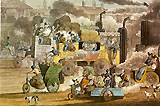 As the picture at the right shows, many attempts were being made in England by the 1830's to develop a practical vehicle that didn't need rails. A series of accidents and propaganda from the established railroads caused a flurry of restrictive legislation to be passed and the development of the automobile bypassed England. Several commercial vehicles were built but they were more like trains without tracks.
As the picture at the right shows, many attempts were being made in England by the 1830's to develop a practical vehicle that didn't need rails. A series of accidents and propaganda from the established railroads caused a flurry of restrictive legislation to be passed and the development of the automobile bypassed England. Several commercial vehicles were built but they were more like trains without tracks.
The development of the internal combustion engine had to wait until a fuel was available to combust internally. Gunpowder was tried but didn't work out. Gunpowder carburetors are still hard to find. The first gas really did use gas. They used coal gas generated by heating coal in a pressure vessel or boiler. A Frenchman named Etienne Lenoir patented the first practical gas engine in Paris in 1860 and drove a car based on the design from Paris to Joinville in 1862. His one-half horse power engine had a bore of 5 inches and a 24 inch stroke. It was big and heavy and turned 100 rpm. Lenoir died broke in 1900.
Lenoir had a separate mechanism to compress the gas before combustion. In 1862, Alphonse Bear de Rochas figured out how to compress the gas in the same cylinder in which it was to burn, which is the way we still do it. This process of bringing the gas into the cylinder, compressing it, combusting the compressed mixture, then exhausting it is know as the Otto cycle, or four cycle engine. Lenoir claimed to have run the car on benzene and his drawings show an electric spark ignition. If so, then his vehicle was the first to run on petroleum based fuel, or petrol, or what we call gas, short for gasoline.
Siegfried Marcus, of Mecklenburg, built a can in 1868 and showed one at the Vienna Exhibition of 1873. His later car was called the Strassenwagen had about 3/4 horse power at 500 rpm. It ran on crude wooden wheels with iron rims and stopped by pressing wooden blocks against the iron rims, but it had a clutch, a differential and a magneto ignition. One of the four cars which Marcus built is in the Vienna Technical Museum and can still be driven under its own power.
In 1876, Nokolaus Otto patented the Otto cycle engine, de Rochas had neglected to do so, and this later became the basis for Daimler and Benz breaking the Otto patent by claiming prior art from de Rochas.
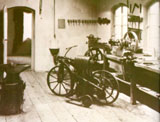 The picture to the left, taken in 1885, is of Gottllieb Daimler's workshop in Bad Cannstatt where he built the wooden motorcycle shown. Daimler's son Paul rode this motorcycle from Cannstatt to Unterturkheim and back on November 10, 1885. Daimler used a hot tube ignition system to get his engine speed up to 1000 rpm
The picture to the left, taken in 1885, is of Gottllieb Daimler's workshop in Bad Cannstatt where he built the wooden motorcycle shown. Daimler's son Paul rode this motorcycle from Cannstatt to Unterturkheim and back on November 10, 1885. Daimler used a hot tube ignition system to get his engine speed up to 1000 rpm
The previous August, Karl Benz had already driven his light, tubular framed tricycle around the Neckar valley, only 60 miles from where Daimler lived and worked. They never met. Frau Berta Benz took Karl's car one night and made the first long car trip to see her mother, traveling 62 miles from Mannheim to Pforzheim in 1888.
Also in August 1888, William Steinway, owner of Steinway & Sons piano factory, talked to Daimler about US manufacturing right and by September had a deal. By 1891 the Daimler Motor Company, owned by Steinway, was producing petrol engines for tramway cars, carriages, quadricycles, fire engines and boats in a plant in Hartford, CT.
Steam cars had been built in America since before the Civil War but the early one were like miniature locomotives. In 1871, Dr. J. W. Carhart, professor of physics at Wisconsin State University, and the J. I. Case Company built a working steam car. It was practical enough to inspire the State of Wisconsin to offer a $10,000 prize to the winner of a 200 mile race in 1878.>(see more on J. W. Carhart story from Fredric Dennis Williams)
The 200 mile race had seven entries, or which two showed up for the race. One car was sponsored by the city of Green Bay and the other by the city of Oshkosh. The Green Bay car was the fastest but broke down and the Oshkosh car finished with an average speed of 6 mph.
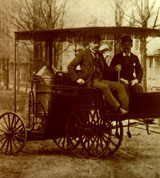 From this time until the end of the century, nearly every community in America had a mad scientist working on a steam car. Many old news papers tell stories about the trials and failures of these would be inventors.
From this time until the end of the century, nearly every community in America had a mad scientist working on a steam car. Many old news papers tell stories about the trials and failures of these would be inventors.
By 1890 Ransom E. Olds had built his second steam powered car, pictured at left. One was sold to a buyer in India, but the ship it was on was lost at sea.
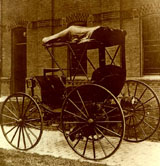 Running by February, 1893 and ready for road trials by September, 1893 the car built by Charles and Frank Duryea, brothers, was the first gasoline powered car in America. The first run on public roads was made on September 21, 1893 in Springfield, MA. They had purchased a used horse drawn buggy for $70 and installed a 4 HP, single cylinder gasoline engine. The car (buggy) had a friction transmission, spray carburetor and low tension ignition. It must not have run very well because Frank didn't drive it again until November 10 when it was reported by the Springfield Morning Union newspaper. This car was put into storage in 1894 and stayed there until 1920 when it was rescued by Inglis M. Uppercu and presented to the United States National Museum.
Running by February, 1893 and ready for road trials by September, 1893 the car built by Charles and Frank Duryea, brothers, was the first gasoline powered car in America. The first run on public roads was made on September 21, 1893 in Springfield, MA. They had purchased a used horse drawn buggy for $70 and installed a 4 HP, single cylinder gasoline engine. The car (buggy) had a friction transmission, spray carburetor and low tension ignition. It must not have run very well because Frank didn't drive it again until November 10 when it was reported by the Springfield Morning Union newspaper. This car was put into storage in 1894 and stayed there until 1920 when it was rescued by Inglis M. Uppercu and presented to the United States National Museum.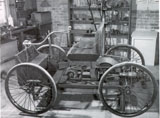 Henry Ford had an engine running by 1893 but it was 1896 before he built his first car. By the end of the year Ford had sold his first car, which he called a Quadracycle, for $200 and used the money to build another one. With the financial backing of the Mayor of Detroit, William C. Maybury and other wealthy Detroiters, Ford formed the Detroit Automobile Company in 1899. A few prototypes were built but no production cars were ever made by this company. It was dissolved in January 1901. Ford would not offer a car for sale until 1903.
Henry Ford had an engine running by 1893 but it was 1896 before he built his first car. By the end of the year Ford had sold his first car, which he called a Quadracycle, for $200 and used the money to build another one. With the financial backing of the Mayor of Detroit, William C. Maybury and other wealthy Detroiters, Ford formed the Detroit Automobile Company in 1899. A few prototypes were built but no production cars were ever made by this company. It was dissolved in January 1901. Ford would not offer a car for sale until 1903. The first closed circuit automobile race held at Narragansett Park, Rhode Island, in September 1896. All four cars to the left are Duryeas, on the right is a Morris & Salom Electrobat. Thirteen Duryeas of the same design were produced in 1896, making it the first production car.
The first closed circuit automobile race held at Narragansett Park, Rhode Island, in September 1896. All four cars to the left are Duryeas, on the right is a Morris & Salom Electrobat. Thirteen Duryeas of the same design were produced in 1896, making it the first production car.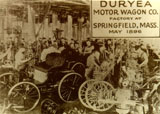 At left is pictured the factory with produced the 13 Duryeas. In 1898 the brothers went their separate ways and the Duryea Motor Wagon Company was closed. Charles, who was born in 1861 and was eight years older than Frank had taken advantage of Frank in publicity and patents. Frank went out on his own and eventually joined with Stevens Arms and Tool Company to form the Stevens-Duryea Company which was sold to Westinghouse in 1915. Charles tried to produce some of his own hare-brained ideas with various companies until 1916. Thereafter he limited himself to writing technical book and articles. He died in 1938. Frank got a half a million dollars for the Westinghouse deal and lived in comfort until his death in 1967, just seven months from his 98th birthday.
At left is pictured the factory with produced the 13 Duryeas. In 1898 the brothers went their separate ways and the Duryea Motor Wagon Company was closed. Charles, who was born in 1861 and was eight years older than Frank had taken advantage of Frank in publicity and patents. Frank went out on his own and eventually joined with Stevens Arms and Tool Company to form the Stevens-Duryea Company which was sold to Westinghouse in 1915. Charles tried to produce some of his own hare-brained ideas with various companies until 1916. Thereafter he limited himself to writing technical book and articles. He died in 1938. Frank got a half a million dollars for the Westinghouse deal and lived in comfort until his death in 1967, just seven months from his 98th birthday.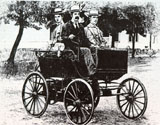 In this engraving Ransom Eli Olds is at the tiller of his first petrol powered car. Riding beside him is Frank G. Clark, who built the body and in the back are their wives. This car was running by 1896 but production of the Olds Motor Vehicle Company of Detroit did not begin until 1899. After an early failure with luxury vehicles they established the first really successful production with the classic Curved Dash Oldsmobile.
In this engraving Ransom Eli Olds is at the tiller of his first petrol powered car. Riding beside him is Frank G. Clark, who built the body and in the back are their wives. This car was running by 1896 but production of the Olds Motor Vehicle Company of Detroit did not begin until 1899. After an early failure with luxury vehicles they established the first really successful production with the classic Curved Dash Oldsmobile.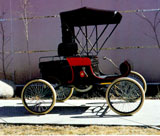 The Curved Dash Oldsmobile had a single cylinder engine, tiller steering and chain drive. It sold for $650. In 1901 600 were sold and the next years were 1902 - 2,500, 1903 - 4,000, 1904 - 5,000. In August 1904 Ransom Olds left the company to form Reo (for Ransom Eli Olds). Ransom E. Olds was the first mass producer of gasoline powered automobiles in the United States, even though Duryea was the first auto manufacturer with their 13 cars.
The Curved Dash Oldsmobile had a single cylinder engine, tiller steering and chain drive. It sold for $650. In 1901 600 were sold and the next years were 1902 - 2,500, 1903 - 4,000, 1904 - 5,000. In August 1904 Ransom Olds left the company to form Reo (for Ransom Eli Olds). Ransom E. Olds was the first mass producer of gasoline powered automobiles in the United States, even though Duryea was the first auto manufacturer with their 13 cars.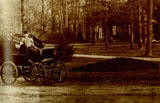 Ransom Olds produced a small number of electric cars around the turn of the century. Little is known about them and none survive. The picture at left is the only known picture of one of these rare cars. It was taken at was taken at Belle Island Park, Michigan. In 1899 and 1900, electrics outsold all other type of cars and the most popular electric was the Columbia built by Colonel Albert Augustus Pope, owner of American Bicycle Company.
Ransom Olds produced a small number of electric cars around the turn of the century. Little is known about them and none survive. The picture at left is the only known picture of one of these rare cars. It was taken at was taken at Belle Island Park, Michigan. In 1899 and 1900, electrics outsold all other type of cars and the most popular electric was the Columbia built by Colonel Albert Augustus Pope, owner of American Bicycle Company.an interesting footnote to the Olds electric.
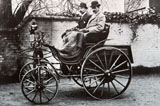 J. A. Koosen and H. Lawson in a 1895 Lutzmann. This is typical of American design in the mid 1890's. It was truly a horseless carriage. Tiller steering, engine under the floorboards, very high center of gravity, not designed for road travel. Imagine climbing into one of these and trying to drive across town and around a few corners. Kind of scary, huh?
J. A. Koosen and H. Lawson in a 1895 Lutzmann. This is typical of American design in the mid 1890's. It was truly a horseless carriage. Tiller steering, engine under the floorboards, very high center of gravity, not designed for road travel. Imagine climbing into one of these and trying to drive across town and around a few corners. Kind of scary, huh? This Daimler of 1899 was owned by Lionel Rothchild. The European design is much advanced of the American designs of the same time. Gottlieb Daimler took part in the London-to-Brighton run in 1896 but died in 1900 at the age of 66 without ever meeting Benz. His German engines powered the automobile industries of Britain and France.
This Daimler of 1899 was owned by Lionel Rothchild. The European design is much advanced of the American designs of the same time. Gottlieb Daimler took part in the London-to-Brighton run in 1896 but died in 1900 at the age of 66 without ever meeting Benz. His German engines powered the automobile industries of Britain and France. The 1908 Haynes in the back ground shows the rapid development of the petrol powered car when compared to the 1894 model in the foreground. Consider the present difference between a 1998 Tarus and the 14 year old 1984 Tarus. Some difference. Old man Haynes claimed to have build the 1894 car in 1893 but had no proof.
The 1908 Haynes in the back ground shows the rapid development of the petrol powered car when compared to the 1894 model in the foreground. Consider the present difference between a 1998 Tarus and the 14 year old 1984 Tarus. Some difference. Old man Haynes claimed to have build the 1894 car in 1893 but had no proof.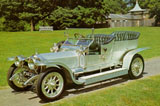 The Rolls Royce Silver Ghost of 1906 was a six cylinder car that stayed in production until 1925. It represented the best engineering and technology available at the time and these cars still run smoothly and silently today. This period marked the end of the beginning of the automobile.
The Rolls Royce Silver Ghost of 1906 was a six cylinder car that stayed in production until 1925. It represented the best engineering and technology available at the time and these cars still run smoothly and silently today. This period marked the end of the beginning of the automobile.How The Car Changed The County, Town by Town
 In 1903, in Winfield, Kansas Mr. H. T. Trice is seen standing in from of the first car in town. Acutally it was more like a truck and was used to haul customers out to see land. The railroads brought potential customers to town and Mr. Trice picked them up at the depot and took them out to his new developments.
In 1903, in Winfield, Kansas Mr. H. T. Trice is seen standing in from of the first car in town. Acutally it was more like a truck and was used to haul customers out to see land. The railroads brought potential customers to town and Mr. Trice picked them up at the depot and took them out to his new developments. By 1915 racing had become a passion all over the United States. A typical local race track was at the Cowley County Fairgrounds in Winfield, Kansas. The local obsession with horse racing, started by the earliest settlers in 1870, turned to the new technology of auto racing. Local farm boys who were familiar with motors and equipment used their talents on cars and motorcycles to go faster than anyone in the county.
By 1915 racing had become a passion all over the United States. A typical local race track was at the Cowley County Fairgrounds in Winfield, Kansas. The local obsession with horse racing, started by the earliest settlers in 1870, turned to the new technology of auto racing. Local farm boys who were familiar with motors and equipment used their talents on cars and motorcycles to go faster than anyone in the county. The horse racing facilities were quickly converted to the new, faster, more dangerous, and thus more exciting, motor racing. See Bob Lawrence's Home Page for new sections on both Auto Racing and Motorcycle Racing in Cowley County, Kansas
The horse racing facilities were quickly converted to the new, faster, more dangerous, and thus more exciting, motor racing. See Bob Lawrence's Home Page for new sections on both Auto Racing and Motorcycle Racing in Cowley County, Kansas Eventually the automobile change the face of small town America. The town gentry bought cars, albiet fashoned to match their station in life. In Winfield, Kansas, Main Street went from a gathering place for people and horses and wagons to a parking place for the ubiquitous automobile. The Trolley Cars were displaced to make room for more cars. The brick streets were covered with asphalt to provide a smoother ride for the automobile. The old fire maps of Winfield show the inexorable spread of the automobile and all of the supporting businesses. Filling stations, auto dealers, battery stations, oil depots all grew and expanded to displace to older technologies of the day. R. B. Sandford's Winfield Carriage Works appears on the fire-map of Block 127 in 1918. But on the same spot on Block 127 in 1925 it has been replaced by a Battery Station and an Auto Storage facility.
Eventually the automobile change the face of small town America. The town gentry bought cars, albiet fashoned to match their station in life. In Winfield, Kansas, Main Street went from a gathering place for people and horses and wagons to a parking place for the ubiquitous automobile. The Trolley Cars were displaced to make room for more cars. The brick streets were covered with asphalt to provide a smoother ride for the automobile. The old fire maps of Winfield show the inexorable spread of the automobile and all of the supporting businesses. Filling stations, auto dealers, battery stations, oil depots all grew and expanded to displace to older technologies of the day. R. B. Sandford's Winfield Carriage Works appears on the fire-map of Block 127 in 1918. But on the same spot on Block 127 in 1925 it has been replaced by a Battery Station and an Auto Storage facility.
After a century of the automobile, we can begin to assess the effects of long term transport by internal combustion. Nearly every aspect of our lives has developed around this technology. Only now, are we seeing new digital communications technologies, of the internet and beyond, that may eventually displace some of the functions of the automobile and replace our current problems with a new set that you, our grandchildren, will be charged with solving. Ask your grandparents about their first car. I'm sure you will get to hear a great story.
Search Results
The first car ever running live! The Benz Motorwagen (1885 ...
https://www.youtube.com/watch?v=qVkvH0nm8pU
Nov 28, 2007 - Uploaded by SquirrelAndRope
This is rare footage of the world's first car's engine igniting & running. ... Ford Model T - How to Start & How ...Who built the first automobile? - Ask History - History Channel
www.history.com/...history/who-built-the-first-auto...
Dec 11, 2012
Who inspired Henry Ford to get into the car business? See whymotorized wheels have been called one of ...Automobiles - Facts & Summary - HISTORY.com
www.history.com/topics/automobiles
History of the automobile - YouTube
https://www.youtube.com/watch?v=b_vw2QHYqls
Aug 8, 2014 - Uploaded by Audiopedia
The history of the automobile begins as early as 1769, with the creation of steam ... By the start of the 20th ...History of Electric Vehicles - Early Years
inventors.about.com/.../estartinventions/.../History-O...
The DeLorean Motor Company may soon start building 'new ...
www.theverge.com/.../delorean-motor-company-new-l...
1 day ago
The DeLorean Motor Company may soon start building 'new' cars... DeLorean anticipates new cars to ...Automobile History - Inventors - About.com
inventors.about.com/.../cstartinventions/.../Car_Histo...
How car engine really starts. - YouTube
https://www.youtube.com/watch?v=LPn7CtfZlT0
Oct 26, 2012 - Uploaded by TechTrixInfo.com
How starter motor starts a car engine how starter motor works with an ... the drive how fly wheel start to ...Let's Get Started with Driving - YouTube
https://www.youtube.com/watch?v=_2HA_-FWdF4
Oct 2, 2011 - Uploaded by MarutiDrivingSchool
Let's get started with ABC of driving online. ... Learn to Drive aCar for Beginners - Duration: 4:41. Svtuition ...Early Automobiles and Motor Cars, 1910's - YouTube
https://www.youtube.com/watch?v=GyzXLlq07I8
Mar 3, 2011 - Uploaded by MyFootage001
Early silent footage of various early automobiles and motor carsfrom the 1900's. ... to make the car start ...
Stay up to date on results for first motor vehicle started.
Create alertSearch Results
Car - Wikipedia, the free encyclopedia
https://en.wikipedia.org/wiki/Car
Jump to History - History. Main article: History of the automobile. The first working .... and coach manufacturer, started to build cars in 1897 :p.66 and ...
History of the automobile - Wikipedia, the free encyclopedia
https://en.wikipedia.org/wiki/History_of_the_automobile
In 1768, the first steam powered automobile capable of human transportation was built .... While seven vehicles were registered, only two started to compete: the ...
You visited this page on 28/1/16.
People also ask
Benz Patent Motor Car, the first automobile - Daimler AG
https://www.daimler.com/company/tradition/...history/1885-1886.html
On January 29, 1886, Benz applied for a patent for his “vehicle powered by a gasengine.”.The First Car - A History of the Automobile
www.ausbcomp.com/~bbott/cars/carhist.htm
A Quick History of the Automobile for Young People .... The local obsession with horse racing, started by the earliest settlers in 1870, turned to the new ...The first car ever running live! The Benz Motorwagen (1885 ...
https://www.youtube.com/watch?v=qVkvH0nm8pU
Nov 28, 2007 - Uploaded by SquirrelAndRope
This is rare footage of the world's first car's engine igniting & running. ... Ford Model T - How to Start & How ...Who invented the automobile? (Everyday Mysteries: Fun ...
https://www.loc.gov/rr/scitech/mysteries/auto.html
The history of the automobile is very rich and dates back to the 15th century when Leonardo da Vinci was creating designs and models for transport vehicles.Who Invented the Car? - LiveScience
www.livescience.com/37538-who-invented-the-car.html
Jun 18, 2013 - The credit for inventing the first practical modern automobile goes to Karl Benz, ... With the profits Benz was free to start building a horseless, ...Who built the first automobile? - Ask History - History Channel
www.history.com/news/ask-history/who-built-the-first-automobile
Dec 11, 2012 - Who inspired Henry Ford to get into the car business? See whymotorized wheels have been called one of the greatest inventions in modern ...Automobiles - Facts & Summary - HISTORY.com
www.history.com/topics/automobiles
Although the blueprint for the modern automobile was perfected in Germany and France in the late 1800s, Americans dominated the industry in the first half of ...The History of the Automobile
l3d.cs.colorado.edu/systems/agentsheets/New-Vista/automobile/
Automotive production on a commercial scale started in France in 1890. ... The first automobile produced for the masses in the US was the three-horsepower, ...Searches related to first motor vehicle started
Kharghar, Navi Mumbai, Maharashtra - From your Internet address - Use precise location



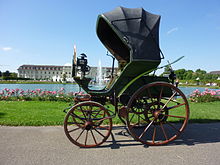
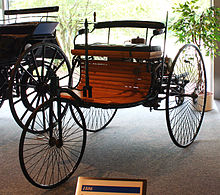




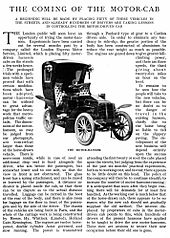



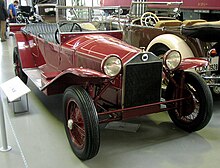




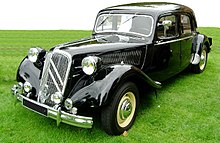


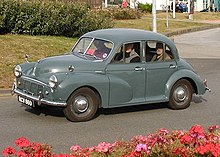



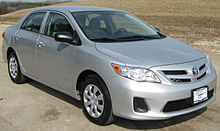







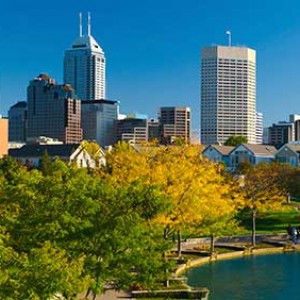



No comments:
Post a Comment